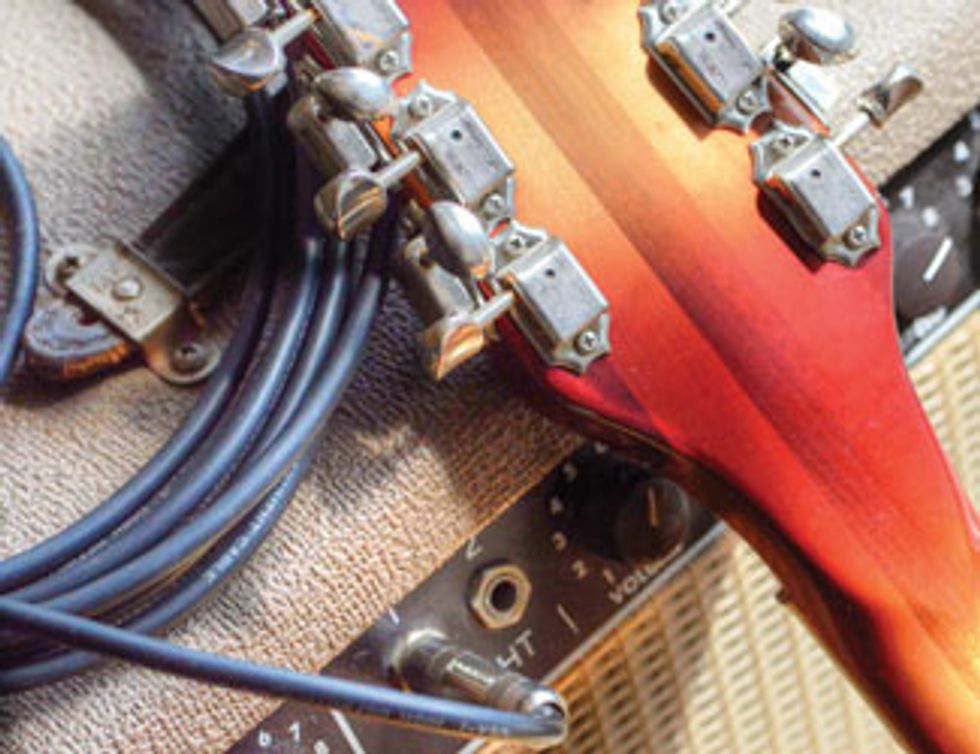Why don’t all guitars sport sturdy, break-resistant pegheads?

The headstock: We may take it for granted, but a good design balances many considerations.
Tripping over cords onstage is a professional hazard. It’s stupid, we’ve all done it, and sometimes with disastrous results. I recall doing it one time in front of a club full of onlookers, and unfortunately, the cable was connected to my guitar that was standing on a riser. I watched helplessly as my favorite guitar—a Rickenbacker— bounced once on its headstock and then sprung into the air like a pogo stick before coming back down again on its face. The entire event lasted just a few seconds, but the damage was done. A clean crack of about 4" now ran through the 4th- and 5thstring tuner holes. Unbelievably, the guitar was still in tune and I was able to carry on with the gig. Was I just lucky or did the design give my axe more of a chance?
Over the years, different guitars have acquired reputations for their ability (or not) to stand up to abuse. So why don’t all guitars sport sturdy, break-resistant pegheads? As a builder, headstock strength is only one small item on my checklist of concerns when designing a guitar, and as always, it’s a balancing act. Of course, you can eliminate the headstock completely and move the tuners to the opposite end of the string length. It’s hard to break something that isn’t there.
To design a headstock, you have to think in terms of three dimensions, or axes. We usually think about the first two when considering the shape of the design as viewed from the front. This affects string length and angle relative to the guitar’s centerline. The two-dimensional design is what gets the most attention because the peghead shape is often the signature of a guitar. Designing a head shape that’s unique isn’t as easy as it might seem because there are quite a few absolutes that have to be obeyed. It really comes down to geometry, which is determined by the path of the strings. The lines of the strings are generally tapering down to a single point that is theoretically off the end of the headstock. If you want to keep the line straight, there is a finite place where this line intersects the outside diameter of the tuner capstan post. Straight string pull has an effect on both tuning and vibration transfer, and they are somewhat at opposite ends of the tug-of-war. If the design calls for this straight string pull, the limiting factor for shape is now the clearance distance between the tuning machine’s gear housing and the inside edge of the tuning key. There are various ways to address this—curves, stairsteps, and angles—but there’s not a lot of wiggle room on the sides. This generally leaves the tip of the headstock to make your statement. In order to go beyond this constraint, a builder will have to angle or “break” the string as it comes off the nut, which is generally the case.
There is also much debate about overall headstock mass and the effect it has on sound and sustain. Some claim that a small headstock robs sustain, while others believe that larger headstocks siphon off vibration. I think it’s more complex than just size. I do, however, believe that the headstock does vibrate in the manner of a tuning fork at the end of the neck, and it can be tuned to enhance, or at least vary, a guitar’s nature. Anyone who has clamped a capo to the end of the headstock will tell you it makes a difference.
Another often-overlooked aspect of the headstock is that a string’s overall length determines its tension at pitch—longer being tighter. This may be one of the most important things to consider when determining the tuner locations, with the difference between in-line and split-side configurations being the most obvious. In-line designs can make the overall length longer, and the strings at each end are subject to different amounts of tension. A builder can manipulate the lengths to change playability and tone this way. Another way to balance tension is to split the sides unevenly by, say, four and two, or even five and two for 7-string instruments. Any approach will have consequence in size, strength, and sound.
So far, we’ve just looked at two-dimensional shape, which is pretty easy. Drawing in two dimensions on a flat surface isn’t really designing, because it doesn’t take into account a number of structural demands that exist in three dimensions. The third axis gives us the backwards headstock angle needed to seat the strings firmly in the nut. A most notable exception to this is Leo Fender’s design, which accomplishes almost the same effect by scalloping away the headstock’s face to create string angle. The shortcoming here is the need for string trees to increase the break angle, which can hamper tuning stability. The payoff is ease of manufacture and cheaper material costs, along with a very robust headstock. It’s pretty hard to snap a straight piece of maple.Pitched headstocks create good string contact within the nut. That helps both the transfer and reflection of vibration to the neck, and therefore to the body. I believe that sustain can be enhanced by string angle. I’m not suggesting that sustain is the only characteristic worth chasing, but it is one of the factors to consider within the whole. Again, the balance to be struck is that too much angle can create problems by not allowing the strings to stretch and slide across the nut when bending notes or tuning. Headstock pitch also helps determine access to the truss rod from the nut end of the neck. The flatter the pitch, the more elongated the access hole must be (if you’ve ever looked at a Rickenbacker truss rod cover you’ll know what I mean). The other answer to this dilemma is to bend the end of the truss rod upward in its last few inches, which can create other problems like uneven adjustment and “S” curves.
My personal headstock design is a medium size with quite a bit of pitch. If I’m concerned about a customer bouncing it off the drum riser, I might suggest some reinforcement under the headplate, or even a switch to a stronger wood. Balancing decisions about other specifications can mitigate any sacrifice in tone. But in the end, it’s not a cricket bat—it’s a musical instrument. Have some respect and try not to put your guitar in a place where it can get kicked over.
 Jol Dantzig is a
noted designer, builder,
and player who co-founded
Hamer Guitars,
one of the first boutique
guitar brands, in 1973.
Today, as the director of
Dantzig Guitar Design, he continues to
help define the art of custom guitar. To
learn more, visit guitardesigner.com.
Jol Dantzig is a
noted designer, builder,
and player who co-founded
Hamer Guitars,
one of the first boutique
guitar brands, in 1973.
Today, as the director of
Dantzig Guitar Design, he continues to
help define the art of custom guitar. To
learn more, visit guitardesigner.com.

